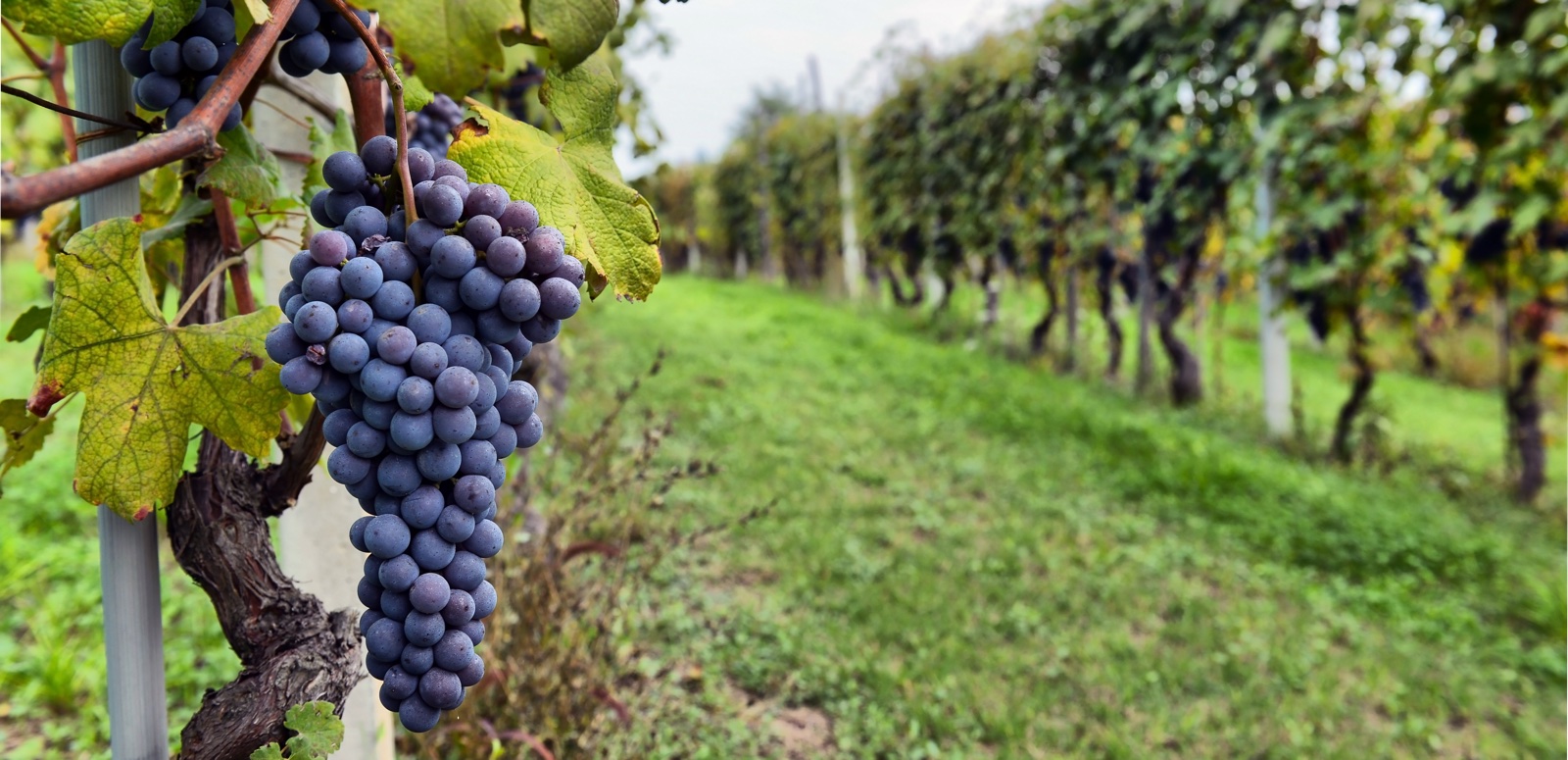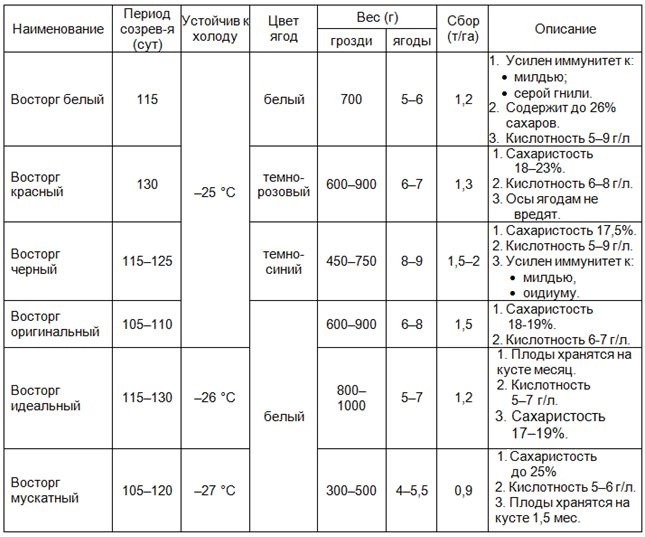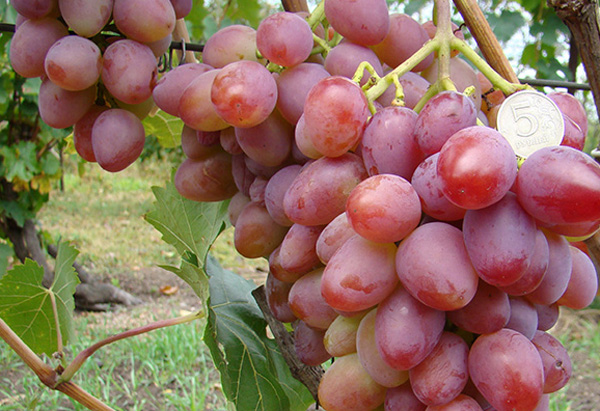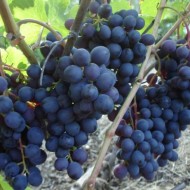A variety of tastes and aromas: how to grow Delight grapes in the country
Content
Breeding history of the variety
Russian scientists were engaged in the creation of grapes, taking the Amur wild variety as a basis and crossing it with three common crops. The progenitors of the variety were:
- Zarya Severa, which gave the "newcomer" the ability to withstand the Russian frosts;
- Dolores, which made it possible to obtain a variety that tolerates transportation well;
- Early Russian, sharing quality taste and early ripening.
As a result, a new hybrid was created, entered in the State Register of Breeding Achievements in 1992.

According to plant breeders, the culture is unpretentious, resistant to plant ailments, high-yielding and pleasant to the taste. Thanks to its qualities, Delight grapes quickly spread throughout Russia. Delight is successfully grown in the central regions, in the Urals and the Far East, as well as in Siberia.
Cultural plantations are often found near neighbors - in Ukraine, Belarus and the Baltic countries.
Varieties of grapes Delight
The novelty of Russian breeders turned out to be so successful that soon dozens of varieties appeared on its basis - Muscat, Ideal, Pink, etc. They have many similarities, but there are differences, which makes it possible for farmers and summer residents to select a hybrid suitable for their conditions ...
For example, the classic version of the variety allows you to get massive bunches with white berries. It is he who is more often found in personal plots.
Here is a brief summary table of grape varieties derived from the Delight variety (and retaining the name of the progenitor in the name).

Now let's consider the characteristics of some varieties in more detail.
Delight is white
It is the leader among the rest in terms of the content of vitamins and microelements. Berries with a dense skin, which guarantees:
- no problems with transportation;
- immunity from pollinating insects.
Ripening periods range from 90 to 120 days. She does not need shelter and protection from the cold. Diseases common among grape crops are not terrible.
Description of the bush and bunches
With abundant harvests, the plant may not support the total weight. It is recommended to prune the bushes from the first year of life.
The bunches are conical or irregular, massive. The mass of one bunch is 500 g or more, in rare cases up to 2 kg. The density of the grapes is average.
The weight of one berry ranges from 6-7 g. Oval-shaped, white. The core is crispy, the rind is firm but edible. Sugar content - 18-26%, acidity - 5-9 g / l.
The maturation of the shoots is normal. Fruiting is up to 85% of the total, the average number of clusters per shoot is 1.6. The approximate yield is 130 c / ha.
Taste qualities and marketability
The crop can be kept on the bushes for up to one and a half months, while maintaining the presentation and taste.Convenient to carry. To grow delicious fruits, you need:
- periodic watering;
- large portions of fertilizers;
- top dressing.

Diseases and resistance of the variety
Withstands frosts down to -25 ° С. Resistant to mildew and gray mold. To combat diseases, prophylactic spraying against mildew is recommended, adding compositions from oidium to the solution. The variety is prone to phylloxera, therefore, a stock from the side of Berlandieri x Riparia Kober 5BB is desirable for the bushes.
Delight red
Ripens early, about 125 days. A flower with a feminine function, needs a bisexual variety culture nearby. If plants have the same flowering period, pollination occurs.
To reduce the weight load on the bush, it is recommended to leave 22–25 full-fledged shoots, given that each one forms from 12 to 15 bunches.
The culture needs careful care, it is shown:
- large formations;
- green operations;
- potash and phosphorus fertilizers.
Successful selection of the landing site is also important. Immune to mildew, oidium, gray rot.
In order for the crop to remain on the bushes longer, high supports are equipped for the vines.
Characteristics of the bush and bunches
The culture is medium-sized. Shoots with fruits are counted up to 70%, for each there are 1–1.5 bunches.
The bunches are massive, weight within 600–800 g. Conical shape, moderate looseness.
The grapes are red, large, weighing from 6 to 8.5 g. The shape is nipple or oval.

Taste and commercial qualities
Sugar content is 18-23%, acidity - 6-8 g / l. The pulp is fleshy, delicate delicious taste. The peel is thin, so care must be taken when transporting.
Drought and winter hardiness
Able to withstand frosts down to -25 ° C. Needs regular watering so that young shoots take root faster.
Delight original
Culture of the early ripening period (106–115) days.
Plant morphology
Bushes are medium to tall. The bunches are massive, weight - 600-900 g, some specimens - up to 1.5 kg. The shape is cylindrical, beveled, the density is average.
Taste qualities and marketability
The berries are very large, their weight is 6–8 g. The shape is oval, the color is white. The taste is pleasant. The heart is fleshy and juicy.
Resistance to natural disasters
Disease resistance at 3 points on a 5-point scale. Immune to mildew, oidium, gray rot. Frost resistance - up to -25 ° С.
Delight is black
The second name is Black Baron. Ripens in 110-125 days. Bushes are tall. Bears fruit in 2-3 years. Shoots with fruits are 70-85%. Bushes need a larger area for nutrition, serious formation and regulation of the total weight of the fruit.
Characteristics of the bush and bunches
The bunches are massive, weight - 400-750 g, some specimens reach 2.5 kg. Clusters are loose or moderately dense. The fruits are large, oval and round, the color of the berries is dark blue.
Taste and commercial characteristics
Sugar content - 17.5%. Thick fleshy, light sweetish taste. Collection - about 200 c / ha.
Diseases and resistance of the variety
Resistant to mildew, oidium, weakly resists gray rot. Pollinated by any bisexual variety that matches the flowering time.
Frost resistance reaches -25 ° C, but it is advisable to cover the shoots for the winter.
- White
- Black
- Red
Video "Description of grapes Delight"
This video presents the quality characteristics of the white variety.
General rules of agricultural technology
Most varieties of Delight grapes do not require special care and are unpretentious in choosing a place. Good yields are obtained simply by following the basic agronomic requirements.
Place and time for boarding
It is advisable to pick up the site on the sunny side (south or southwest), away from trees with a dense crown, where there are no drafts. The soils are suitable for the following: black soil, loam.
They are planted in moderately moist soil, excess moisture contributes to decay of seedlings. The best time for disembarkation is autumn.
Delight grape care
The culture tolerates winter well, but first-year seedlings need to be additionally insulated. When the time for the rapid development of roots begins in spring, timely watering will be needed, since there will be little moisture in the soil.
Breeding methods for grapes
You can use the grafting method with the help of seedlings. Vaccination is preferable, since the danger of phylloxera is eliminated.
Crops of high and medium growth are suitable for the stock. Experts recommend the stock Berlandieri x Riparia Kober 5BB - it is resistant to cold, fungi and phylloxera. Cuttings are prepared even before frost.
The operation is performed as follows. The scions are cut (sharp blade, disinfected) from the fruiting bush, then disinfected and stored in a refrigerator (at -5 ° C), wrapped in polyethylene. Inoculated in the spring, as soon as the buds hatch on the scion. For this, the branches are placed in a bucket of water and kept indoors at a temperature of +15 ° C. Vaccination is carried out by budding or splitting.

The Delight variety is easy to breed and grow. Bushes do not need additional winter shelters, and they do not need frequent watering. Even a novice winegrower can cope with the task.



